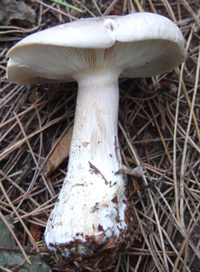ExCEPtional! – The Penny Bun, Cep or Porcini mushroom
The Bolete genus (and those closely related) are some of the largest and most exciting mushrooms to be found out there. From a culinary point of view there are several that are more than worth the their place in the kitchen, but there is one in particular that stands out as ‘best of the rest’.
 So let’s get it’s name sorted out. Most people will definitely recognise common/local names, a couple of which are not English in origin. Our common tongue has described this as the ‘Penny Bun’ for obvious reasons (although probably not to todays generation), many also know it as the Cep (French) but then most cooks and chefs will often know it from it’s Italian translation as the ‘Porcini mushroom’. But at the end of the day, science has kept things in order, strictly labeling it as Boletus edulis – the latin name ‘edulis’ simply meaning ‘edible’. Very apt, as usual.
So let’s get it’s name sorted out. Most people will definitely recognise common/local names, a couple of which are not English in origin. Our common tongue has described this as the ‘Penny Bun’ for obvious reasons (although probably not to todays generation), many also know it as the Cep (French) but then most cooks and chefs will often know it from it’s Italian translation as the ‘Porcini mushroom’. But at the end of the day, science has kept things in order, strictly labeling it as Boletus edulis – the latin name ‘edulis’ simply meaning ‘edible’. Very apt, as usual.
Excluding Truffles, the Cep (as I’ll call it from now on) is one of the most highly prized edible finds, especially in mainland Europe. Some foragers only have this one mushroom on their list, such is their passion for it.
It is a very distinctive looking mushroom with it’s stout, chunky stem and small ‘out of proportion’ cap (common to younger examples – shown opposite). They can sometimes pop up in abundance or smaller groups, but are often solitary near/under broad-leaved and coniferous trees.
The picking season can be as early as June or July, but often show up from August to September. With this year’s season being mostly dry, only November has been reliable in dishing out the goods – for me this year anyway!
Young specimens are usually favoured over older specimens (often maggot-ridden) and will be cooked or pickled whole, or even dried for later consumption. They freeze extremely well too.
The pores in older ‘middle-aged’ specimens change from white to a dull yellow-green colour (as the spores are olive green/brown). The tubes are usually removed and the cap is thinly sliced along with the stem (peeled first) to add to the pan. Overall, it’s good to know there are many ways to store, cook and eat this mushroom. I’m no top chef , but there’s lots of ideas out there. A great selection of recipes with the cep mushroom can be found on the BBC website here.
There are a couple of edible ‘look-a-likes’ often confused with the Cep, such as the The Dark Cep (Boletus aereus) and maybe the Bay Bolete (Boletus badius). But beware the Bitter Bolete (Tylopilus felleus) with a dark network on its stem. Although not posionous, it’s a recipe for disaster when served up at dinner time. As the name suggests it has a very bitter, unpleasant taste.
So a useful feature to note in identifying the Cep is looking for the raised ‘white’ network/pattern on the stem (reticulation) as shown in the picture below. None of those mentioned above share this feature.
Good hunting…

What a difference! A large middle aged/mature specimen next to a younger example. Notice the ‘white’ raised network on the stem and how the pores age ‘yellow/green’ compared to the paler white colour of younger ones.

A young, perfectly from Cep mushroom discovered in Leicestershire UK – open grassland near woodland.
QUICK ID TABLE: CEP Boletus edulis |
CAP / FLESH 8-25cm across. Brown. White line at margin of cap. Smooth and dry becoming greasy. Viscid in wet weather. Flesh is white (flushed dingy yellow or vinaceous in the cap). STEM 3-23cm x 3-8cm. Often swollen at base. Pale with white network covering the stem. PORES / TUBES / SPORE PRINT Pores are small and round, initially white; ageing yellow, then greenish-yellow. Tubes are white, becoming grey-yellow. HABITAT / SEASON In coniferous, broadleaved or mixed woods. Summer – late autumn. EDIBILITY Edible. Excellent. |
The Genus BOLETUS (the Boletes): Characteristics to look out for: • Have pores (open ends of tubes) on the underside instead of gills. Easily separated from the cap. |











